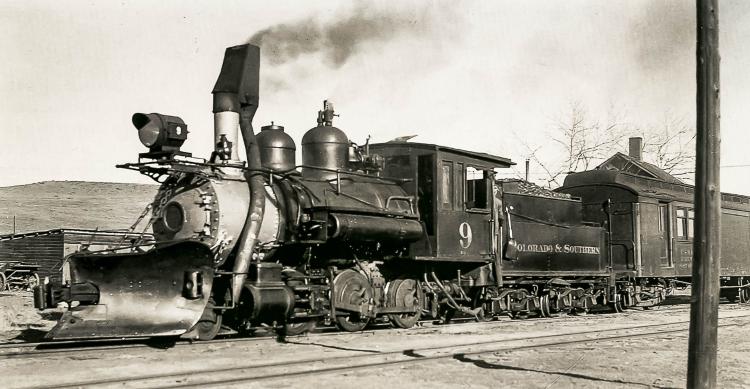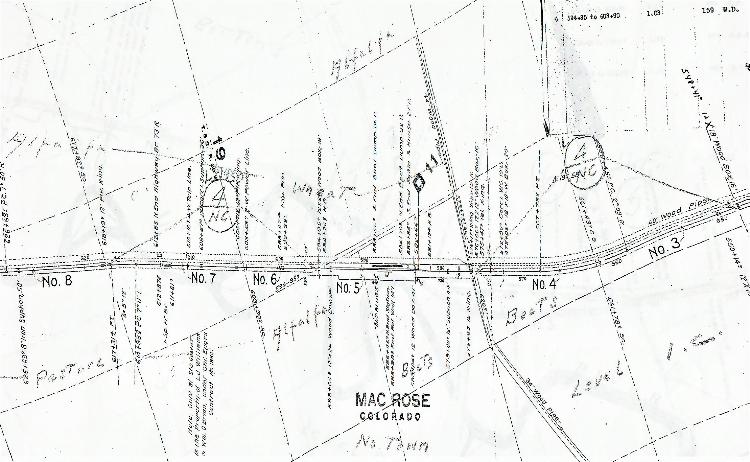C&S Station at Littleton / Wynetka / Mac Rose...
|
This post was updated on .
I have long been puzzled by the seemingly total lack of photographs and detailed descriptive information on the narrow-gauge Denver, South Park & Pacific (DSP&P) / Denver, Leadville & Gunnison (DL&G) / Colorado & Southern (C&S) depot just south of the intersection of Platte Canyon Road and Bowles Avenue west of Littleton.
>>> QUESTION: Does anyone have any photos of the Littleton/Wynetka/Mac Rose depot, or "valuation" descriptive data for the building? I believe it was a 24x40 frame depot built sometime prior to 1885, and at some point, a 12x12 addition was added as living quarters. I am inserting the only image (Lad G. Arend, 1931) I have ever seen of "Mac Rose," which actually only shows the roofline over the top of the RPO on a southbound C&S train. However, even this photo is puzzling, since the (1918) ICC Valuation Map shows the depot on the east side of the track, with a siding and a short retaining wall being on the west side of the track. However, in the photo, the building appears on the west side of the track, so I am not sure that it is actually the depot, even though the photograph is clearly labeled as being at "Mac Rose."  I am also inserting a detailed section of the (1918) Valuation Map for Mac Rose. For orientation purposes, the southbound C&S right-of-way is running right to left, and modern-day Platte Canyon Road runs along the west edge of the C&S right away. The road entering near bottom-right and exiting at near top-center is Bowles Avenue. The town of Littleton is a mile or so out of view beyond the bottom of the diagram.  LOCATION DATA: – As background, early newspaper accounts indicate the "Littleton Depot" was proposed as early as 1874, even before the DSP&P had finished grading south along what would eventually become Platte Canyon Road. By 1 Dec 1880, they were listing it as "Station #11" (flag stop), with "R.S. Little" listed as the "acting agent." It is not clear whether a physical station building had actually been erected yet, or if Littleton-founder Richard Sullivan Little (1829-1899) was simply selling local train tickets and doing similar railroad freight & express business from his offices at his "Rough & Ready Flour Mill" near the current intersection of Bowles Avenue and South Santa Fe Drive in Littleton. – While the actual construction date for the DSP&P Littleton Depot (m.p. 11.20) has not yet been documented, it is reported that by Jul 1885, it was a 24x40 frame depot with O.W. Judd serving as station agent. Separate records indicate there was a 12x12 addition to the depot, apparently for use as living quarters. – By 1889, things get a little confusing when "Wynetka" was incorporated near the Bowles Ave. & Platte Canyon Road intersection, although the village had also used other names to include "Lilleyville," "West Littleton," and "Chapmans Corners." The 1889 plat was later vacated in 1892. Regardless, railroad timetables of the period, continue to call the flag stop "Wynetka" station, but now listing it as m.p 11.15. – Regardless, the C&S changed the station name at "Wynetka" milepost 11.15 to "Mac Rose" on 15 Feb 1906, thus verifying that they were one and the same. -- In summary, "Littleton," milepost 11.2, is last mentioned by the Denver Leadville & Gunnison (DL&G) in 1889 and had a 987-foot siding. In 1893, the DL&G listed "Wynetka" m.p, 11.15 as having a 987-foot siding, thus suggesting they were actually one and the same, with the milepost simply being just slightly adjusted. The C&S continued to list the 987-foot narrow-gauge siding as of 1 July 1900, but then it was extended to 330 feet on 11 September 1912, and by 1937, it was slightly reduced to 256 feet. – At milepost 12.11 there was also another flag stop called Rosendahal / Magnus Park from 1893 until about 1912 and only included a 50x80 platform. This was almost exactly 1 mile south of the station at Mac Rose and the Platte Canyon Road/Bowles Avenue intersection TRACKAGE NOTES: – DSP&P grading had been completed to "Littleton" by 1877, with construction completed and train service beginning in 1878. A third rail was laid to Chatfield milepost 14.11 in 1939 to allow standard-gauge service to the sugar beet load-out at that location. The inner narrow-gauge rail was then removed between Chatfield and Denver by 5 Dec 1942, leaving the line as standard-gauge only, and once the ICC authorized abandonment on 15 Mar 1950, the tracks were soon removed from Chatfield to Sheridan Junction, just south of Hamden Avenue, AFE #11505. – On a side note, after the C&S Platte Canyon line was cut back from Waterton to Chatfield, effective 21 Nov 1942, there were no longer any turning facilities south of Sheridan Junction, so all operations after 1942 were "push-pull" movements involving a standard-gauge C&S steam engine pulling a string of gondolas down to the sugar beet load-out at Chatfield, dropping them off, and then in a backing-movement, returning any loaded gondolas back to Sheridan Junction. In the final years of operation, a total of (64) carloads were handled in 1946, and (63) carloads were handled in 1947, all destined for the Great Western Sugar Company north of Denver. The final C&S standard-gauge revenue freight to actually operate from Chatfield through Mac Rose and on north to Sheridan Junction made its last run on 17 Dec 1947, and as stated previously, the line then remained dormant until 15 Mar 1950 when the ICC finally authorized abandonment and removal of the rails, which occurred shortly thereafter. – As an additional side note, sugar beets were once very much part of the Littleton and upper Platte Valley economy, and in the 1950s, even the D&RG briefly operated a sugar beet load-out on the long siding south of the D&RG depot, and almost exactly east of the current restored-D&RG depot/coffee shop location. Additionally, Littleton truck-builder "Coleman Motors" even developed a front-wheel-drive truck with a very low-sided dump-bed for easy hand-loading of sugar beets.
Craig H. Trout
|
|
As I continue to search for photos of the C&S Station at Littleton / Wynetka / Mac Rose, I have also begun to speculate on just what it may have looked like.
At first, I considered C&S "flag stop" depots constructed during roughly the same time frame, to include Fort Logan, Dome Rock, Estabrook, and Kenosha, working on the assumption that many depots built during the same era used the same general layout design. However, all of these listed depots appear to be of the 18x24 design, and while some even include an addition in back of about the right dimensions, none appear to be of the reported 24x40 design with a 12x12 addition as living quarters. >> Can anyone think of examples of 24x40 frame depots built in the 1882-1885 time frame?
Craig H. Trout
|
Re: C&S Station at Littleton / Wynetka / Mac Rose...
|
In reply to this post by chtrout
Type in Littleton in the search.It will direct you to the C&S #9 video which shows it pulling away from that building.Hit pause quick enough and you can see part of the building.
|
Re: C&S Station at Littleton / Wynetka / Mac Rose...
|
In reply to this post by chtrout
The Valuation field notes don't even show a depot at MacRose (spelled in the valuation Macrose). It lists a painted Station sign, a privy, a Section House and a Tool House. The tool house is 12 x 16 x 8'2". However, on the track map field notes it shows a building at 86+82 identified as a "Station Building". No further information. The tool house is shown at 89+00. The Scale House at 84+00. The Beet Chute extends from 84+75 to 89+56.
Rick |
Re: C&S Station at Littleton / Wynetka / Mac Rose...
|
In reply to this post by Robert McFarland
It would seem that one of the Klinger books or THE SOUTH PARK LINE would have a picture.Or Chris orTodd(or Bob Shoppe or Jeff Ramsey)Panoramic maps on DPL.Ropers Doghouse.
|
|
This post was updated on .
In reply to this post by Robert McFarland
Robert, Not sure that is video clip is Mac Rose. There is a railroad crossing "crossbucks" to the left of the building, and it looks a bit more like Sheridan Junction perhaps. There was no road crossing to the left (south) of Mac Rose that I am aware of.
Craig H. Trout
|
|
In reply to this post by Robert McFarland
Yes, Tom Klinger has a copy of this photo in his book.
Craig H. Trout
|
|
This post was updated on .
In reply to this post by chtrout
Getting a bit off-C&S-topic, I continue to wonder what the "roofline" above the RPO car might be, since all indications are that the actual depot should be to the right of the photographer, and on "his" side (east) of the tracks. Based on its location, I am wondering if it might actually be associated with the old "Spotswood House."
– As historical background, Littleton-pioneer John G. Lilley (1832-1909) had first established this 320-acre farm in 1862 along what is now Platte Canyon Road, after arriving in the area with his friend Joseph Wesley Bowles (1836-1906) from their Central City gold-mining-related activities. In 1887, Lilley sold his farm to "Col." Robert J Spotswood (1838-1910) who had made his fortune running stagecoach lines both in the mountains and north to Wyoming. Spotswood called his place "The Valley Stock Farm," although it was referred to locally as simply the "Spotswood Ranch." In August 1905, Spotswood sold out to George S. Newman, who in turn renamed the ranch "The Mac Rose Stock Farm" after his widely-known prize thoroughbred horse. Accordingly, while the C&S Littleton depot had been renamed "Wynetka" (Spotswood had been a town trustee) in about 1892, the station was once again renamed "Mac Rose" in 1906 in honor of the "The Mac Rose Stock Farm." Accordingly, that "may" be buildings associated with the "Mac Rose" (Spotswood) farm in the background.
Craig H. Trout
|
«
Return to C&Sng Discussion Forum
|
1 view|%1 views
| Free forum by Nabble | Edit this page |

